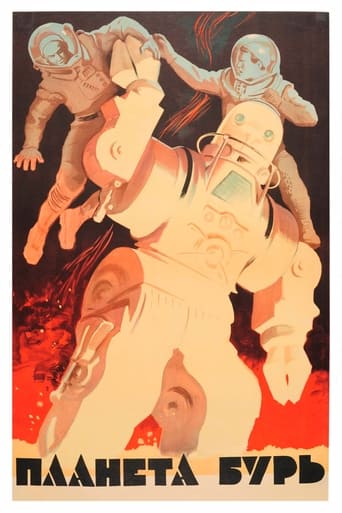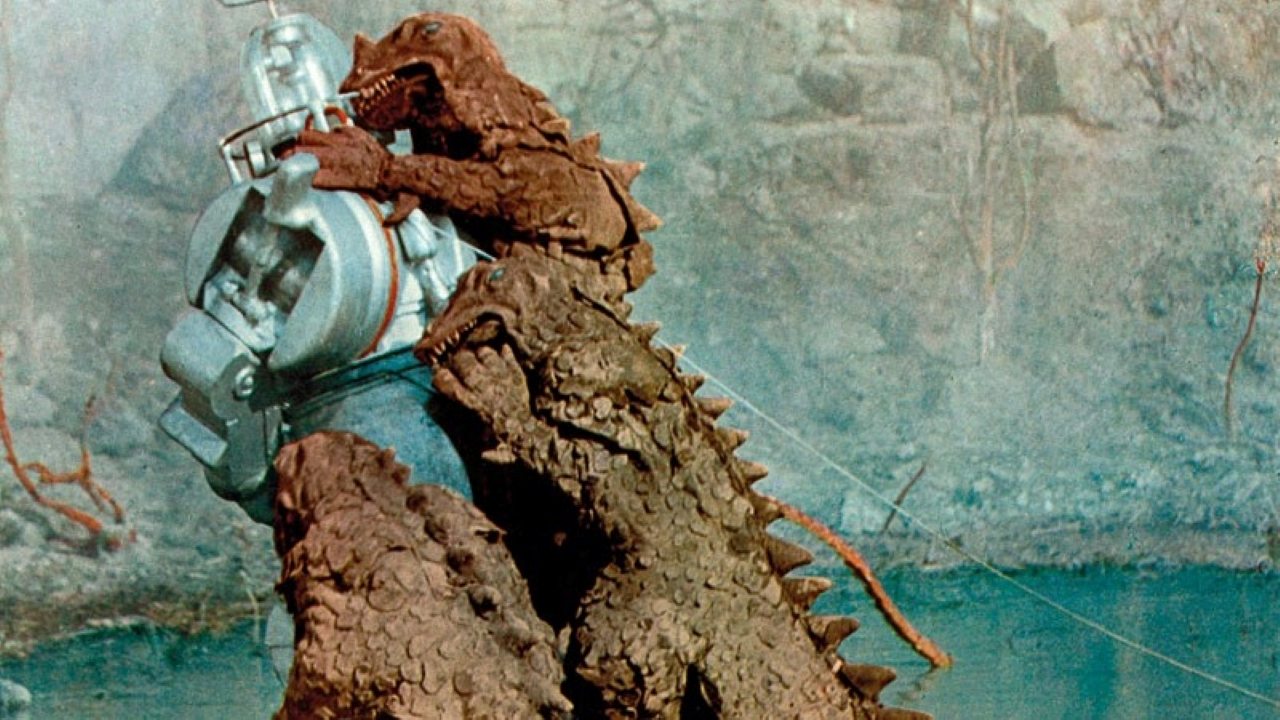Lee Eisenberg
People in the United States most likely know that in the '50s and '60s, Hollywood made a number of movies about people traveling to other planets. It turns out that the Soviet Union also made one. Pavel Klushantsev's "Planeta bur" ("Planet of the Storms" in English). It's a typical corny, enjoyable sci-fi flick. The destination in this case is Venus, and the cosmonauts get more than they bargained for. The robot was funny.I understand that Curtis Harrington and Peter Bogdanovich each individually took the movie, added new scenes, and released it under different titles. Well, I doubt that I'll ever be interested in the adulterated versions. I prefer this original. Had the Soviet Union celebrated Halloween, I bet that millions of children would have dressed as that robot.Fun movie.
dlee2012
Planeta Bur is another strong 1960s film from behind the Iron Curtain. Along with the likes of Ikarie XB-1 and First Spaceship on Venus, this production shows that film-makers in the communist countries were committed to producing high-quality films with a kind of gritty realism lacking in the output of their Hollywood rivals.Like most Soviet films, the production has some technical problems. The direction is very rudimentary, the colour film stock of extremely poor quality and the sound is muffled. There is no great artistry here but, despite these limitations, it is a thoroughly pleasurable science fiction film and stands head and shoulders above most Hollywood output, then and now.If anything though, this film suffers from being a little too much like First Spaceship on Venus. It features the same realistic voyage, landing on a surreal alien world, deployable surface vehicles and maintenance robot. Unfortunately, it suffers a little in comparison for whereas Stanislaw Lem was able to write about a truly alien world, this film falls back on the old and erroneous clichés of Venus being a young planet and thus features dinosaurs and the like.Nevertheless, the first half of the film is extremely strong, with an emphasis on realism in space flight. Gone are the contrivances found in most American science fiction of ships with unscientific, magical properties like faster-than-light engines and the ridiculous need for ray guns, space battles and the like. Here is a comparatively realistic space craft and a story that shows that one can encounter just as much drama exploring one's own solar system.Some of the acting is wooden but the characters are slightly better defined than in First Spaceship to Venus. The robot is, for the most part, realistically portrayed as a useful tool though there is, unfortunately, a moment of unintentional camp when rain affects its circuits, causing it to babble incoherently. Falling into campiness is a danger when creating films in this genre and, despite this moment, the writer and director successfully avoid this trap for the most part.Another fortunate thing is that the film is virtually devoid of Soviet propaganda, making it all the more watchable today.The greatest problem, though, lies in the journey's end. Venus is an interesting, alien world at first but one's interest quickly wanes and the aforementioned dinosaurs will only captivate very young children. Science fiction should present an estranged view of humanity, allowing us to reflect on ourselves and our society from afar. Lem's film does this by showing how the aggressive Venusians destroyed themselves through their imperialist ambitions and experimentation with nuclear weapons.This film, presenting a primeval world, holds up no such mirror to humanity. It does present a hope that we can work together to explore space in the future so there is a vaguely utopian feel but there is no real critique of society so it ultimately fails to be really effective science fiction.Nevertheless, despite these shortcomings, due to its realism, atmosphere and plausible depiction of robots and other space hardware, it remains an enjoyable film, just not a profound one. It is a refreshing and superior alternative to Hollywood science fiction films with their emphasis on violence, camp and fantastical space craft.
tedg
I'm of the opinion that film is powerful, powerful enough that large segments of our imagination is guided by cinematic relationships. That even the nature of reasoning is affected, even as deeply as how we reinvent practical logic. There are lots of examples to show and arguments to be made -- they are in a collection I am incubating.Science fiction is a special case, at once more obvious. Not all as subtle as what I study. But surely it had as profound an effect on daily lives.To understand this film, you need to know some history. Alas, many readers will not appreciate the cold war that was the overriding impetus for the two largest political entities from the 50s through the 80s.Some dates for you. In 56, the US saw "Forbidden Planet," with a superintelligent robot, space travel and mind augmentation. It was based on Shakespeare's most interesting play and is still among the best scifi films.In 57, Russia launched a satellite and declared that they "owned" space (and would put nuclear bombs over the US ready to "drop"). Also, that soon, they would have men in space.In 58 one of the most successful Russian filmmakers (Klushantsev) made a film about "cosmonauts" and space travel that was enormously successful with the Russian public (and their captive peoples). That film was the beginning of a deeper than usual partnership between Klushantsev and the propaganda arm of the Kremlin.In 1960, an unknown in East Germany made a film (Road to the Stars) about cosmonauts on Venus. It was a runaway hit. In the following year, Kennedy made his famous pledge to put an American on the moon by the end of the decade.The Soviet moon program had some catastrophic disasters, in large part resulting from lies told to the old Stalin regime by Soviet scientists working on ballistic missiles supposedly (but not really) capable of destroying the US. Khrushchev had these scientists destroyed or imprisoned. That meant no moon program.But the people already were convinced that Venus was the prize, so the space propagandists seized on this and retooled their manned program as a race to Venus, forget the moon. As a consequence, Klushantsev was given a (for the times and conditions) vast budget and told to make a film of the heroic Soviet nation exploring Venus. This he did in the film you'll see here if you can find it.Our intrepid crew is asked to make the Soviet people proud, a promise they come back to a few times. There's a robot, clearly stolen from "Forbidden Planet."The thing revolves around there being life on Venus. Just as they take off, they find proof that the life consisted of humans. Afterthey leave, we see a beautiful woman appear. Then, as the spacecraft flies home, we have a few minutes of a Soviet heroes song in that militant, deliberately fake spontaneous joyous tone of the times.The effects developed by this team would be used in strange circumstances for the next 8 years. This crew filmed fake footage of real spaceflights. The Kremlin was never so bold as to fake a success when everyone knew the missions ended in fiery death. But they did decorate their successes with these true-fake movies. The most famous was the 65 spacewalk of Leonov, wonderfully believable until you wonder who is holding the camera. Oddly, the propagandists assumed that the camera eye was such a magical omnipresence that no one would ask.Anyway, this film was somehow procured by the infamous Roger Corman. He shortened it and dubbed in English. He substituted the blank female (who says in an orbital craft) with an even more blank female. One wonders why; Faith Domergue had been hot 15 years earlier but here is wallpaper. And he adds an earthside leader who radios a few times, played by the already embarrassing Basil Rathbone. Something interesting could be said about his Sherlock Holmes here.Kubrick's 1968 2001, used many conventions from this shop, even when they went against the science of the thing. And ever since, on through "Star Wars," we have that single vision of what space SHOULD look like.Ted's Evaluation -- 2 of 3: Has some interesting elements.
timayres
I saw this in my childhood and took years to track it down again since I saw it under one of its two confusing Roger Corman english-language re-edits [Voyage to the Prehistoric Planet with Basil Rathbone added, and Voyage to the Planet of Prehistoric Women, with mermaids scenes directed by Peter Bogdonavich.] Finally able to track down the original Russian version recently, I was able to fully appreciate the ambitious scope and production values. The forest is truly primeval in its detailed beauty, Robot John both heroic and sad in his dedication, and the ending poetic and lyrical. Non-U.S. science fiction films are doubly exotic, and this one is classic fare.



 AD
AD



